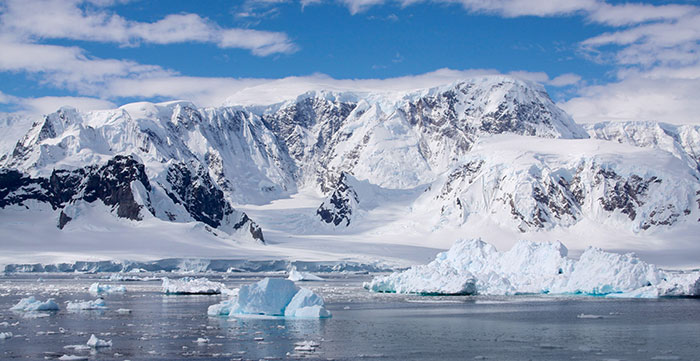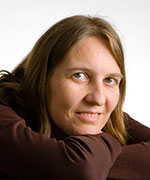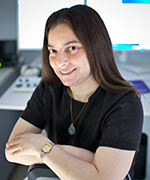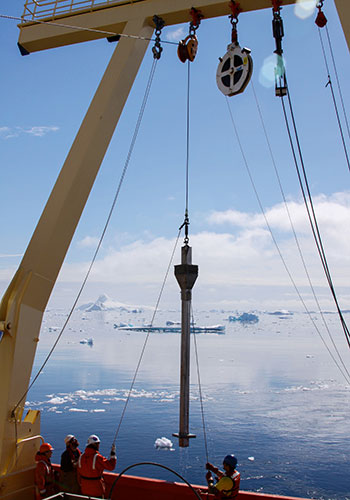Frozen in Time
Professors and students research climate change in Antarctica

Earth and Environmental Studies professors Sandra Passchier and Stefanie Brachfeld go to the ends of the earth for their students, some of whom join them to explore the secrets of climate change hidden beneath Antarctic ice for millions of years.
The two Montclair State geologists are among an elite group of scientists studying in Antarctica in hopes of understanding the forces behind radical environmental change. “I want to look back in time,” says Brachfeld who, like Passchier, has participated in multiple expeditions to the continent that is home to 90 percent of the world’s ice.
Traveling through ice and time
As a teenager, Sandra Passchier became fascinated with ice on a family trip to Norway’s Jostedalsbreen ice cap.
Now a veteran visitor to Antarctica, she first joined an international team of scientists aboard the JOIDES Resolution, a research-drilling vessel, for more than two months in 2010. Supported by grants from the Consortium for Ocean Leadership and the National Science Foundation (NSF), she drilled 1,006 meters beneath East Antarctica to obtain sediment cores that are millions of years old.
By drilling back in time, Passchier says, we can learn more about the Earth’s transition from greenhouse to icehouse that occurred millions of years ago. “I want to understand how polar ice sheets affect sea level rise during periods of global warmth,” she explains.
“Geological records can reveal the mechanisms driving changes in ice sheet size and associated sea-level effects, as well as the long-term processes and climate feedbacks that may affect ice sheets in the present and in the future.”
Palm trees and baobab
Passchier’s post-expedition laboratory research, which is funded through 2014, is yielding insights into both the causes of drastic environmental change and predictions of what the future may hold. “We discovered that about 50 million years ago, the greenhouse world of the Eocene epoch extended all the way to the South Pole region,” she says. “Palm trees and baobab were present on Antarctica at that time.”
Passchier has received NSF funding to run a second research project from 2013 through 2016. Using sediment cores from the Wilkes Land margin, Passchier will establish a record of the advance and retreat of the East Antarctic Ice Sheet through the Eocene-Oligocene transition.
Passchier advises a doctoral student and two master’s candidates who are also members of her research team. “They perform laboratory analyses on drill core samples, interpret the data, deliver oral and poster presentations at conferences and co-write articles for research publications,” she says. She will be recruiting new undergraduate research students for her second project as it gets underway.
A catastrophic collapse
Stefanie Brachfeld’s interest in Antarctica evolved from luck. “I was a graduate student when Amy Leventer, an established Antarctic scientist, came into my adviser’s lab with some questions. I was the only person there that day and ended up gaining a new colleague who later invited me on my first Antarctic expedition.”
Brachfeld returns to Antarctica in April to continue a study of the abrupt changes in the Larsen Ice Shelf System, Antarctic (LARISSA). Funded by the National Science Foundation Office of Polar Programs, the five-year LARISSA project has an international team of geologists, glaciologists, oceanographers and biologists seeking to determine both how climate forces convene to cause ice shelf collapses and to measure their effects on the environment and marine ecosystems.
“In 2002, a chunk of Larsen Ice Shelf B about the size of Connecticut disintegrated within five weeks,” Brachfeld explains. It was just one of several recent catastrophic ice shelf collapses. “These ice shelves hold back land-based ice. Without them, the flow of glacial ice into the ocean speeds up, which causes sea levels to rise. Closer to home, Superstorm Sandy showed us the devastation and destruction that result from high waters.”
The April expedition is the eighth for Brachfeld. One of her graduate students will accompany her. “Since 2004, seven students—four graduate students and three undergraduates—have traveled with me to Antarctica.” Like Passchier, Brachfeld most recently visited Antarctica in 2010. While thick sea ice prevented the LARISSA team from reaching Larsen B, the group was able to recover sediment cores at back-up sites.
Using mud as a tape recorder
“I use mud as a tape recorder,” Brachfeld explains. “I’m looking back at the last 10,000 years—the Holocene epoch—which is an ‘intermission’ between ice ages and which is the baseline against which human-induced climate change is measured.” Preliminary LARISSA project findings suggest that the collapse of the Larsen B ice shelf is new and unique. “There hasn’t been anything like this in 10,000 years,” Brachfeld reports.
Montclair State students—who receive course credit for the trips—participate in every aspect of the research. “They learn how to chart the ship’s course. They collect and process core sediment from the sea floor and below it. They work in the shipboard biology lab to identify organisms from the sea floor. They do a little bit of everything,” Brachfeld says.
Once they return to campus, students work up projects or theses related to their experiences. Last spring, Earth and Environmental Studies students Brendan Reilly ’13 MS and Nadine Orejola ’12 spent six weeks on a LARISSA research cruise. This time, the group reached Larsen A, where they obtained 24-meter-long sediment cores for study.
“People want to know what my favorite part of traveling to Antarctica was,” says Reilly. “There were a lot of amazing things—the penguins and wildlife, sunrises illuminating a sea full of icebergs, the excitement of recovering a great sediment core—but it was the experience of working in the field with an incredible science team that I value the most.” Brachfeld hopes they will finally reach Larsen B in April. “We’ll spend one month aboard Korean Polar Research Institute vessel Aaron. I’m looking forward to it. I enjoy shipboard life,” she says.
Brachfeld hopes they will finally reach Larsen B in April. “We’ll spend one month aboard Korean Polar Research Institute vessel Aaron. I’m looking forward to it. I enjoy shipboard life,” she says.
While life on a research vessel can be pleasant, polar research isn’t easy, Brachfeld says, noting that the three-to four-day Drake’s Passage crossing—between South America and Antarctica—is rough. “Once you get there,” Passchier says, “it can be cold, hard work, 12 to 14 hours a day, seven days a week.”
Despite the hardships and the cold, both women keep going back to Antarctica because, as Passchier puts it, the experience is “nothing less than awesome.”
Caption image left: The view from the back deck of tehUnited State Antarctic Program (USAP) Research Vessel Icebreaker Nathaniel B. Palmer during recovery of a sediment core near Hugo Island, Antarctic Peninsula.
